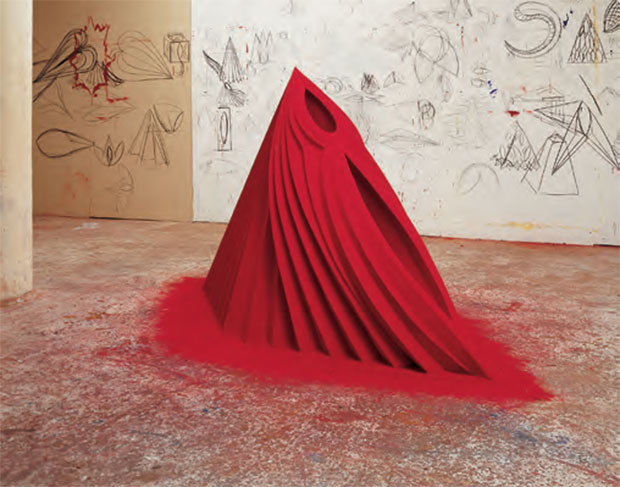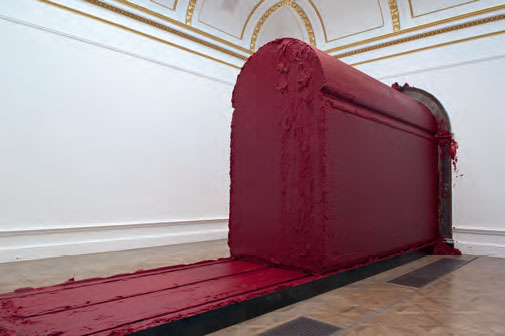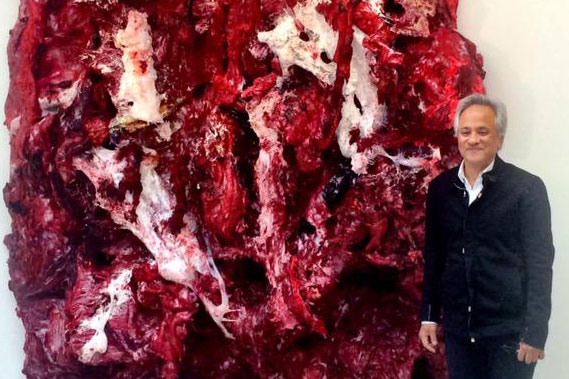
What is it with Anish Kapoor and Red?
Learn why the colour signifies home, earth and motherhood for this remarkable sculptor
While some colours may trigger a wide variety of responses in viewers, red – the colour of human injury – is perhaps the one pigment that almost all of us respond to in the same way. And nowhere is that response more forceful than in the art of Anish Kapoor.
“Kapoor’s reds are intense,” writes Stella Paul in our new book Chromaphilia: The Story of Colour in Art. “For Kapoor, ‘Red is the colour of the earth, it’s not a colour of deep space; it’s obviously the colour of blood and body. I have a feeling that the darkness it reveals is a much deeper and darker darkness than that of blue or black.’ When asked about the colour of his childhood homeland in India, Kapoor commented, ‘I’m sure it’s red’.”
Yet not every red work by Kapoor conveys the same, simple meaning, as Paul explains. “Colour is shaped to suggest fertile origins in Mother as Mountain [top]. It is not a narrative, nor is its form explicit, but the red mound evokes both a geological formation and a woman’s genitals. Kapoor layers multiple allusions, just as he provokes many questions: how is it made? Is it solid? Strewn pigment at the base creates a halo effect, giving the impression that the visible sculpture is simply the tip of an iceberg with hidden wonders below, but this is a fiction. What appears to be a delicate pile of loose powder is a carefully built structure supporting its skin of pigment. Dense, billowy, matt powder was applied methodically, almost ritually.

“Kapoor’s heap of red suggests this and more, but not as a direct correlate. Kapoor celebrates colour’s completely nonverbal nature with proto-verbal symbolism. Without needing words or even articulated thought, colour functions as a direct and visceral route to metaphor."
Kapoor retains that visceral quality even in his more complicated works, by hiding away any makers' marks or mechanisms beneath all this red.
“Part of the power in Kapoor’s work is that it appears self-generating, its processes concealed," Paul goes on. @Svayambh [above] extends that concept, concealing an elaborate infrastructure designed in collaboration with a team of engineers. Further, the apparent results of the work’s kinetic process are part of its fictions. The title is Sanskrit for ‘self-creation’. A colossal block shaped like a train, comprising several tons of gooey red pigment blended with wax and petroleum jelly, moves imperceptibly slowly on a track that passes through doorways smaller than the massive block. The viewer perceives the red train squeezing through each passage, extruding itself, leaving residue behind and creating its own form, again and again. Svayambh seems to sculpt itself, coming into being before our eyes without benefit of the artist’s hand. As Kapoor has commented, artists construct mythologies – they don’t simply make objects.
“Kapoor has returned often to red for its singular capacity to express something fundamental. Red is a bright, extroverted presence that beckons, yet at the same time it stands for a darker, internal world. ‘It’s the colour of the interior of our bodies. Red is the centre.’

For a deeper grasp of colour’s role within art order a copy of Chromophilia: The Story of Colour in Art. The book uses 240 artworks as case studies to tell the story of ten individual colours or colour groups. It explores the history and meaning of each colour in art, highlighting fascinating tales of discovery and artistic passion, and offering easily accessible explanations of the science and theory behind specific colours.
To accompany each of our colour stories inspired by Chromophilia we're pulling together a small Phaidon selection of works by colour that are affordable on Artspace.
Today's works are all red and all are just over or way under £1000 / $1,300. Many of them are by well-known names, among them Assume Vivid Astro Focus, Mickalene Thomas, Lawrence Weiner, Keith Haring, Maurizio Cattelan, Yinka Shonibare, Joan Miró, Tracey Emin, Gustav Metzger, Yayoi Kusama, Chris Ofili, Marcel Broodthaers, Sarah Sze, Raymond Pettibon, Tom of Finland, Jeff Koons, Frank Stella, Shepard Fairey, Sarah Lucas and Marina Abramovic.
So that's all red, all under £1000/$1,300 and all here. (Other colours and price points are, of course, available). Buy Chromophilia here and look out for the next colour story in our new series and check out the art on Artspace.